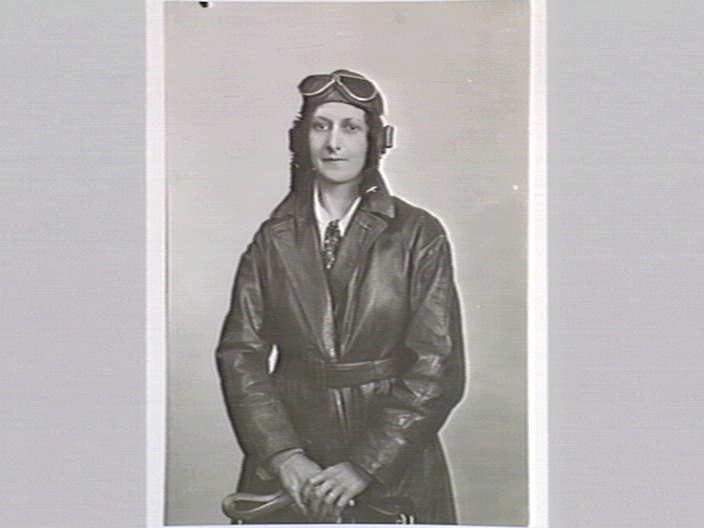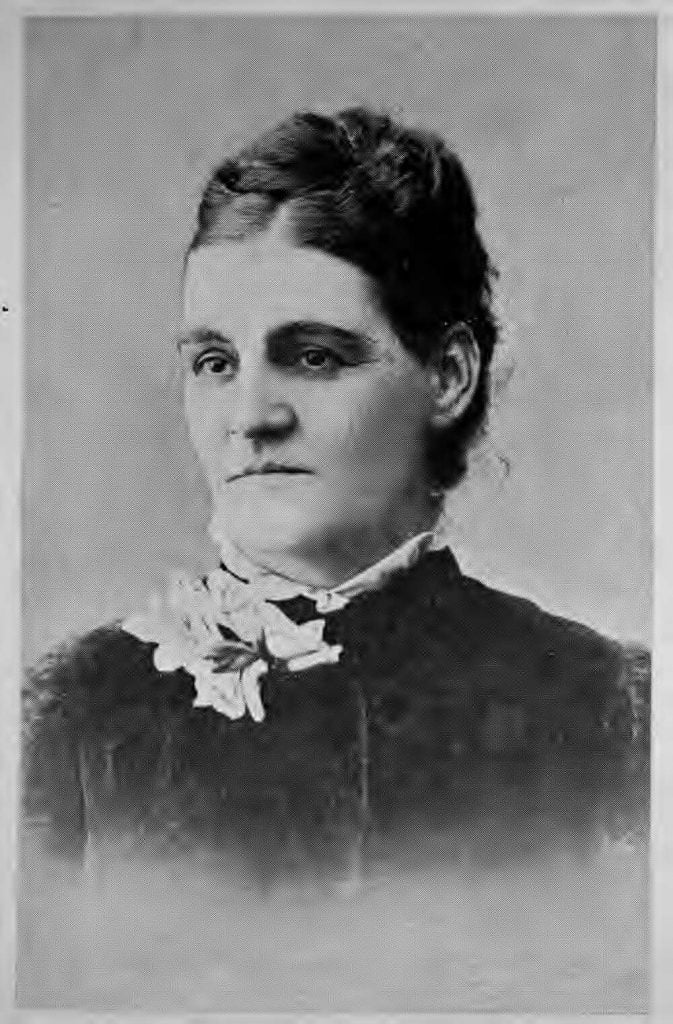International Women’s Day is always a welcome opportunity to share stories of women. Intrepid, individual, inspiring – there are so many lives that came before us and often into obscurity. These highlights are certainly additions to our series of Australian Women You Should Know.
Maude Rose “Lores” Bonney, pioneer aviator

Mrs. Bonney, 1941, H18869
“The world couldn’t hold me…”
In the 1930s when the woman’s place was considered to be the home, the sky represented the greatest freedom: alone in the air and in charge of their destiny, female “aviatrixes” were charting routes and setting records.
One of the more interesting figures in the proud history of female aviation is Maude Bonney. After lessons in secret she became the first woman to gain a commercial pilot’s license, the first woman to circumnavigate Australia by air, and completed daring trips to England and Africa in her Tiger Moth “My Little Ship”.
At one point she crash-landed on a small Pacific island where she befriended the villagers and learned the language – only to be told by repairmen, when they finally arrived, that she would need her husband’s permission to continue on.
Her flying days ended with World War 2. Finding no opportunities for female pilots she went on to other adventures: canoeing up the Amazon, learning the art of Bonsai in Japan… She never gained the fame of her contemporaries like Amelia Earhart but fortunately her determination was captured in the diaries and newspaper articles she wrote, and you can now read about her remarkable life and career.
- Taking flight: Lores Bonney’s extraordinary flying career by Kristen Alexander. LT 629.13092 B6437A
- Pioneer aviator: the remarkable life of Lores Bonney by Terry Gwynn-Jones. LT 629.13 B64G (1988)
Florence Thomson, motorist

Mrs. Thomson’s Wolseley bedecked with flowers at the finishing line of the Reliability Trial from Sydney to Melbourne, 20 to 25 February, 1905, Algernon Darge, 1905, Harold Paynting Collection, State Library of Victoria, H99.100/97
“Of course I knew I was the only lady in the race. But I quite forgot that aspect of the matter as I sped along the roads…”
Another woman going places was Florence Thomson. Throughout her life she toured extensively and independently using all manner of transport: plane, ship, train, horse, camel, palanquin… so naturally, when motor cars appeared on the streets in the early 1900s she taught herself to drive.
She then thought she’d like to drive her car to Melbourne. The journey was slow (15-20 miles per hour), uncharted (Florence had maps drawn by a cyclist who had done the reverse trip), and never done by a female, but she completed it in style wearing breeches, a coat, a tweed cap, a skirt and a veil.
She later drove from Adelaide to Sydney (again, the first female to do so) and was the sole female entrant in the 1905 Dunlop reliability road race, tackling the arduous five-day, 562 miles route of bad roads to place sixth. Her spirit is now recognised with RACV’s annual Florence Thomson tour for women drivers.
- Florence Thomson: pioneering Australian motorist. LTP 796.70994 F662V
Annette Kellerman, professional swimmer, vaudeville star

Miss Kellerman, John Alfred Sears, 1906, H96.160/1361
“I insist that swimming is not only a splendid sport for women but that it is the sport for women — the one sport … in which she can fully compete with men.” – Annette Kellerman, Physical Beauty (1918)
Champion swimmer, diver, swimwear pioneer, fashion influencer, vaudeville star, movie actress, stuntwoman, author, health food entrepreneur… Annette Kellermann’s amazing life was spent blazing pathways and challenging convention.
Born in Australia at a time when women were both underrepresented and encumbered in sport, she followed a successful professional swimming career with aquatic performances then moved into theatre, film, and incredible fame in London and New York.
Along the way she popularised synchronised swimming, invented one-piece bathers for women by sewing stockings to men’s trunks, was arrested for indecency whilst wearing these same bathers (1907), acted the first nude scene on film, was dubbed “The Perfect Woman” for her scientifically ideal physique, and went against convention by proposing to her manager (he said yes).
- The original million dollar mermaid: the Annette Kellerman story by Emily Gibson with Barbara Firth. B 797.20092 G35O
Louisa Lawson, Australia’s first female publisher

Portrait of Louisa Lawson, ca. 1880, National Library of Australia
“And why shouldn’t a woman be tall and strong?”
Henry Lawson is one of Australia’s best-known writers. But some of his talent and success can surely be attributed to the figure he called “the Chieftainess”, his mother Louisa – a poet, author, publisher and suffragette.
She was noted for showing by her own example just what women could do. In 1887 she purchased, edited and wrote most of the Republican newspaper (under the name “Archie”), then, for 17 years, ran Australia’s first feminist journal Dawn: A Journal for the Household Edited Printed & Published by Women with a staff that included a number of women.
As a founder of the Dawn Club (discussing “every question of life, work and reform”) she was an active campaigner for female enfranchisement, using her newspaper editorials to advocate and advise on law, labour and life.
Recognised as a key figure of the suffragette movement, she continued releasing poetry into her old age while her energy and political activism ebbed.
- The first voice of Australian feminism: excerpts from Louisa Lawson’s The Dawn 1888-1895, edited by Olive Lawson. LT 361.994 L44F
- Selected Lead Articles from The Dawn [electronic resource]. Louisa Lawson 1848-1920
Oodgeroo Noonuccal, Indigenous poet and activist

Some of Oodgeroo Noonuccal’s work, including I am proud and other poems, 2010.
“I want to do. / The things I have not done. / Not just taste the nectar of Gods / But drown in it too. / Shed my grass-root skin. / Emerge! / As woman! / poet! / writer! / musician!” – Not My Style (1992)
Another woman of poetry and progress was Oodgeroo Noonuccal. Formerly Kath Walker, she changed her name in the 1980s recognising her Noonuccal ancestors of Minjerribah (North Stradbroke Island) and reflecting a life spent campaigning for indigenous rights.
Leaving school at the age of 13 in 1933, she went on to serve in the Australian Women’s Army Service and the Communist Party of Australia (the only party that welcomed her). Returning to domestic service and raising two sons as a single mother, she had two poetry collections published (the first by an Aboriginal author) and developed a reputation for her unique inflection and direct articulation of Aboriginal feeling.
She became a politically active spokesperson and council member. In her later years she established the Noonuccal-Nughie Education and Cultural Centre, published a series of Aboriginal legends for children, travelled extensively, received four honorary doctorates and remained politically engaged.
- Oodgeroo Noonuccal: poet, painter and elder of her people by Al Grassby ; illustrated by Bruce Smith. JLT A821.3 N73P
- Oodgeroo by Kathie Cochrane (with a contribution by Judith Wright and illustrations by Ron Hurley). LT A821.3 N737C
- Oodgeroo Noonuccal books in SLV catalogue
Mary Gaudron, Australian lawyer & judge

From Moree to Mabo: the Mary Gaudron story by Pamela Burton
“I say to the women lawyers here today just two things: Go to it! Go be yourselves!”
Mary Gaudron’s ascent is one of remarkable dedication and success: after graduating with Sydney University’s Medal in Law in 1965 (whilst working full time and having her first child) she went on to set precedents for Australian women as the first female State Solicitor-General in 1981 and Justice of the High Court of Australia in 1987.
She is noted for her strong opinions and judgements in areas of equality, Indigenous rights and anti-discrimination law, and for her achievement at a time when the legal profession was perceived as a distinctly male domain: clerkship positions for women were rare and attempts to enter chambers were blocked.
Her contribution to Australian law and her influence is felt as an advocate, a jurist and a woman.
- From Moree to Mabo: the Mary Gaudron story by Pamela Burton SLT 347.9403534 G23B.
Henry Handel Richardson, author

Henry Handel Richardson, Lenare, ca. 1924–46, LTAF 1250/323
Born in 1870, Ethel Florence Richardson was highly talented and competitive student at Melbourne’s Presbyterian Ladies College and seemed destined for a musical career before turning to writing while married and living in Europe.
The male nom-de-plume of Henry no doubt enabled her to publish novels now considered classics: Maurice Guest, The getting of wisdom and The fortunes of Richard Mahony.
It was also in defiance of the expectations of women at the time. She wrote strong, complex characters and was one herself, living her last thirty years with a close female friend whilst continuing to write memoirs, diaries and letters that illuminate the times of this pioneering Australian author.
- Henry Handel Richardson: a life by Michael Ackland. LT A823.2 R394A (2004)
- Henry Handel Richardson: fiction in the making by Axel Clark. LT A823.2 R394C
- Finding herself in fiction: Henry Handel Richardson 1896-1910 by Axel Clark. SLT A823.2 R394CL
Useful references
- Murawina: Australian women of high achievement, text by Roberta Sykes and photography by Sandy Edwards. LT 920.00929915 S4M
- Women who made Australian history by Aisling Marlor. SLT 305.420994 M344W
- Strength of purpose: Australian women of achievement from Federation to the mid-20th century by Susanna De Vries. LTF 994.040922 D49S
- Great Australian women by Susanna de Vries. SLT 994.0082 D34G
- Great Queensland women by by Heather Grant. LTF 305.4209943 G76G


Every one of them should be made into a movie. Wonderful role models!
There is a USA movie based on the life of Annette Kellerman called Million Dollar Mermaid (made in 1952) with Esther Williams and Victor Mature if you would like to check it out. Would be nice to see an Australian made documentary series on these great Australian women.
i concur with Carolyn…more australiana
Thank you for this wonderful collection of extraordinary women. Please keep such articles coming – there are so many more to celebrate – so let’s not restrain ourselves to once a year on International Women’s Day.